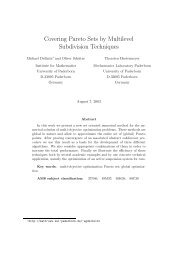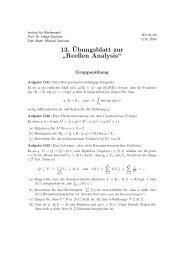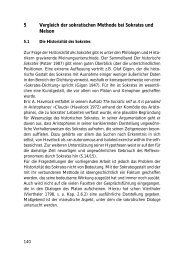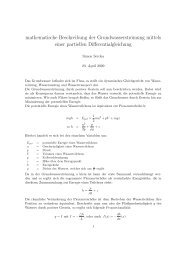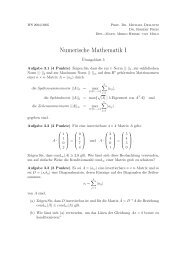Partial Differential Equations
Partial Differential Equations
Partial Differential Equations
Create successful ePaper yourself
Turn your PDF publications into a flip-book with our unique Google optimized e-Paper software.
46 2 First Order <strong>Equations</strong><br />
We compose the <strong>Equations</strong> (2.5), (2.6) and (2.7) to a system which we call the characteristic equations:<br />
⎧<br />
dp<br />
ds (s) = −D xF (p(s), z(s), x(s)) − D z F (p(s), z(s), x(s))p(s)<br />
⎪⎨<br />
= D pF (p(s), z(s), x(s)) · p(s)<br />
(2.8)<br />
dz<br />
ds (s)<br />
⎪⎩ dx<br />
ds (s)<br />
= D pF (p(s), z(s), x(s)).<br />
If (p, z, x): I → F −1 ⊆ R 2n+1 is a solution of (2.8), the functions p, z and x are called characteristics<br />
of the equation F (Du, u, x) = 0. The function x alone also is called the projected characteristic.<br />
From these computations and definitions, we obtain the following theorem:<br />
Theorem 2.2.1. Let U ⊆ R n be an open set, and let u ∈ C 2 (U) be a solution of F (Du, u, x) = 0. If<br />
x: I → R n solves the ordinary differential equation<br />
dx<br />
ds = D pF (p(s), z(s), x(s)),<br />
then (p, z, x) with p(s) = Du(x(s)) and z(s) = u(x(s)) is a solution of the characteristic equations (2.8).<br />
Hence, the method of characteristics consists of the following steps:<br />
• Finally a general solution of the characteristic equations.<br />
• For x 0 ∈ U find a solution (p, z, x) of the characteristic equations and an s 0 with x 0 = x(s 0 ).<br />
• Set u(x 0 ) := z(s 0 ).<br />
Thus, one obtains a candidate for a solution of F (Du, u, x) = 0. For the result, one only needs x(s) and<br />
z(s). The function p(s) can be ignored as long as one does not need it to compute x(s) and z(s).<br />
Example 2.2.2 (Linear equations). We consider equations of the form<br />
F (Du, u, x) = b(x) · Du(x) + c(x)u(x) = 0<br />
with functions b: U → R n and c: U → R. Then, F (p, z, x) = b(x) · p + c(x)z and D p F (p, z, x) = b(x).<br />
Then, the characteristic equation for x(s) is given by<br />
The characteristic equation for z(s) becomes<br />
dx<br />
(s) = b(x(s)).<br />
ds<br />
dz<br />
(s) = b(x(s)) · p(s) = −c(x(s)) z(s).<br />
ds<br />
Here, the characteristic equation for p(s) is not needed.<br />
Example 2.2.3. We consider the boundary value problem<br />
{<br />
x1 u x2 − x 2 u x1 = u on U = {x ∈ R 2 | x 1 , x 2 > 0},<br />
u = g on Γ = {x ∈ R 2 | x 1 > 0, x 2 = 0} ⊆ ∂U,<br />
i.e., we set b(x 1 , x 2 ) = (−x 2 , x 1 ) and c = −1 in the notation of Example 2.2.2. Thus, the characteristic<br />
equations for x and z are<br />
⎧<br />
dx 1<br />
ds<br />
⎪⎨<br />
(s) = −x2 (s),<br />
dx 2<br />
ds (s) = x1 (s),<br />
and one gets the solutions<br />
⎪⎩ dz<br />
ds (s)<br />
= z(s),




